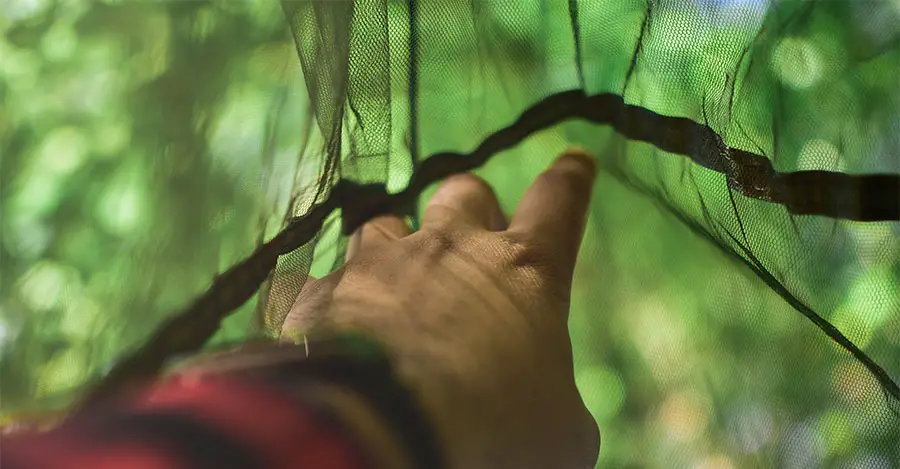Bug net or no bug net? When being exposed to the wild a bug net is definitely something to consider, but do you need to have a bug net?
Do I need a bug net for Hammock Camping?
Yes, you do need a bug net especially if you are camping in warmer weather and/or in low altitude. If you camp in cold weather and/or in high altitude, you don’t really need one. However, it never hurts to have a bug net. Doing so will ensure that you are always protected and won’t have to worry about bug bites or creepy crawlies in the night.
Bug nets are one of those items that I would deem a necessity. We have all been out on hikes, campouts, or backpacking trips where we were eaten alive by bugs. Each climate and season always has its advantages and disadvantages. Insects are usually seen as a disadvantage. Well, I can’t recall offhand any one person that enjoys insects biting or crawling on them. I’m sure there are people out there, but I haven’t run across one.

Dangers of Bug Bites
Most of us humans have experienced being eaten alive by mosquitoes at some point in our lives. I can’t tell you how many times as a kid I would be out camping in the woods and come home the next morning covered in bites. It’s not fun to be in that situation. Dealing with the itchy aftermath just…sucks.
The last thing you will want on a backpacking trip is to be covered in bug bites and have to endure the discomfort for the rest of your trip. It’s a really great way to ruin a perfect hike. All because you were not protected at night. To me, it’s not worth the risk. There are many creepy crawlies actively looking for their next meal. If humans are on the menu, you’re in trouble. Not only is the discomfort of bug bites annoying to deal with, but bugs have the potential to transmit diseases. It is for this reason that a bug net is non-negotiable. It is a must-have in my pack no matter what. Depending on where you live, there’s potential of contracting West Nile Virus, Zika Virus, Yellow Fever, and Malaria just to name a few. These are all really nasty diseases, and I wouldn’t wish them on anyone. So let’s talk about when you need to have a bug net because they are not always necessary.
When you absolutely need to have a bug net
If you’re backpacking or camping in an area that you know for sure there are bugs, it’s worth carrying your bug net. There is such a thing as time and place. You don’t always need a bug net, but I want to give you some things to think about.
Seasons
Spring: This is a season where you will need to use your best judgment. If it’s still consistently cold at nights and has not officially warmed up yet, it’s likely that the bugs haven’t emerged yet. You should be fine if that’s the case.
If it’s been a warmer spring, I wouldn’t risk it and would take my bug net just in case. Better safe than sorry, in my opinion.
Summer: If you’re hiking in the middle of summer it’s pretty much a no-brainer. You know for a fact that you are in bug season. Taking your bug net with you on your trip is wise. That way you stay protected.
Fall: The fall season is pretty much the same as spring. You will need to use your best judgment. If the weather has officially gotten cold and the area has had a few frosts, there’s a good chance that most of the insects have gone. The same thing applies as I mentioned for spring, it would still be a good idea to have your bug net on hand just in case. If you need it, you have it. I have a planned camping trip every November with my boys and it’s usually cold enough to not have to worry about insects. We are able to enjoy ourselves and let me tell you, nothing beats hanging out with your boys and gazing at an endless sky of stars.
Winter: This is pretty easy camping since there are usually no bugs in the winter months. in Even the bugs think your crazy for camping out in the dead of winter. The best part about camping in the winter is that you can be open and free to enjoy the stars.

Going Up? Altitude Matters
The altitude of your camping location matters as well when considering the use of a bug net. If you are down at sea level, you will find that bugs are thriving. It is their safe-haven. The climate is perfect for them to go forth and multiply.
I was always told that when you’re up in the mountains, you don’t have to worry about bugs. I always wondered why until I did some more digging on the subject and discovered the ‘Mosquito Line.’ Apparently, there is an altitude height called the ‘Mosquito Line’ that means once you hit a certain altitude anything above it is pretty much safe from mosquitos and other bitey bugs. The ‘Mosquito Line’ starts about 7,200ft (2200 meters). Most bugs can’t survive at that altitude which is good news for humans. That being said, when you are above the ‘Mosquito Line’ no matter the season or weather, you likely do not need to have a bug net. Even so, I will still be a weenie and carry mine. Like I said, it’s a non-negotiable.
Types of Bug Nets
When it comes to bug nets for hammocks, there are a few different types. Not all bug nets are created equally. No matter which kind you get, be sure that the bug net you choose has a fine mesh that is mosquito-proof and will also keep out no-see-ums or biting midges. There are certain areas of the country that have no-see-ums. I am speaking from personal experience when I say that they are terrible. They bite your skin and they are so small you don’t even know they are on you. Just make sure you read the bug net descriptions carefully and double-check to be sure that they keep out all types of bugs, not only mosquitos.
Attached or Integrated
The connected bug nets, also called integrated, come as one unit with both hammock and bug net together. They are either sewn together with a zipper to get in and out of the hammock or the bug net is zipped onto the hammock. The latter type allows you to have the option of having your bug net on your hammock or not. These, in my opinion, are the best. There’s no fuss or hassle. You just have to set a ridge line and connect the top part of the bug net and your set. That’s not to say that the other types of bug nets are a huge hassle, they’re no biggie, but they are not as easy to use.
The big con to the integrated type is that there is no protection on the bottom of your hammock. There have been claims that people have still gotten bitten through the unprotected bottom-side. I have never personally met anyone that this has happened to though. I find it hard to believe a mosquito can chew through a hammock and a shirt to get to your skin, but who knows? Could be true. Just wanted to mention it in full disclosure.
Separated
These are pretty much the same as the integrated types. The difference is that they offer 360 degrees of protection around your entire hammock. It is basically a tube that you slide your hammock through the middle of. Then you sinch the ends to lock it to the hammock. These also have a zipper to get in and out of them easily. Just like all other bug nets, you have to have a ridgeline too. When you are in your hammock, there is no real difference between these two types. Both offer excellent protection and will keep you bug-free all night.
Ground Style
This type of bug net is beneficial when it comes to protection from all those little buggers. Most ground style bug nets look like a tent that fully encloses your hammock all the way to the ground. They have a zipper to get in and out of the hammock just like a typical tent. The nice thing about this type is that you can move freely in your hammock without having to unzip to get out of it. You can also step outside your hammock to do anything else you might need to do and still be protected. The only real con is that they take a bit more set-up since you have to stake the corners in the ground. Some even come with ground tarps to allow you to have a clean space under your hammock.
Worth its Weight in Gold
For those of you that worry about the weight of your pack like I do, bug nets are relatively lightweight. Most on the market are under a pound. Some backpackers only go with the integrated types since you have less fabric to handle. In the end, this does lighten your load a little bit when you total it all up.
So Do You Need One?
In the end, the real question isn’t “do I need a bug net for my hammock?” I think it’s more along the lines of “which bug net should I get?” There are a lot of good options out there. You will just need to find what suits you best. I think a bug net is a must have for any hammock camper.
Whichever you choose I hope you have a bug free time while you enjoy The Wanderful Wild.
